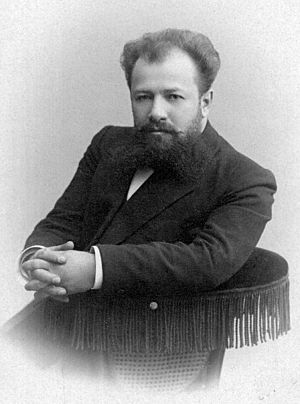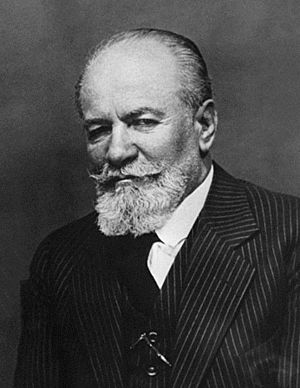Vladimir Nemirovich-Danchenko facts for kids
Vladimir Ivanovich Nemirovich-Danchenko (Russian: Владимир Иванович Немирович-Данченко) was a very important Russian theatre director, writer, and teacher. He helped create the famous Moscow Art Theatre in 1898 with his friend, Konstantin Stanislavski. He was also a producer and helped manage theatres.
About His Life
Vladimir Ivanovich Nemirovich-Danchenko was born on December 23, 1858, in a village called Shemokmedi, near Ozurgeti, in Georgia. He came from a noble family with roots in Ukraine and Armenia. His father, Ivan Danchenko, was an officer in the Russian army. His mother, Aleksandra Yagubyan, was Armenian.
Vladimir went to high school in Tbilisi. Later, he continued his studies at Moscow State University from 1876 to 1879, where he studied subjects like science and law.
In 1879, he left university to work in theatre. He started as a theatre critic, writing reviews about plays. In 1881, his first play, "Dog-rose," was published and performed at the Maly Theatre within a year. He also taught acting to many famous actors, including Ivan Moskvin, Olga Knipper, and Vsevolod Meyerhold.
In 1919, he started the Musical Theatre of the Moscow Art Theatre. This theatre later became the Nemirovich-Danchenko Musical Theatre in 1926. In 1943, he also founded the Moscow Art Theatre School, which is still teaching students today.
Vladimir Nemirovich-Danchenko passed away from a heart attack on April 25, 1943, in Moscow. He was 84 years old.
His Work in Theatre
Nemirovich-Danchenko's Moscow Art Theatre became famous for staging plays by writers like Anton Chekhov and Maxim Gorky. These plays felt very real and full of emotion, which was new for the time. His theatre also put on popular plays based on books by Fyodor Dostoevsky and Leo Tolstoy. People often say that if Konstantin Stanislavski was the "soul" of the Art Theatre, then Nemirovich-Danchenko was its "heart."
Nemirovich-Danchenko helped create the unique acting and directing style of the Moscow Art Theatre. This style was known for its "actors ensemble," meaning all the actors worked together like a team. It also created a special "atmosphere" in the plays. Because of his great skills in directing and producing, the Moscow Art Theatre was considered the best theatre in the Soviet Union at that time.
Even though he was very important, Nemirovich-Danchenko didn't write down his own acting "system" like Stanislavski did. So, we mostly know about the "system of Stanislavski."
Nemirovich-Danchenko received many important awards for his work. He was one of the first people to be named a People's Artist of the USSR in 1936. He also received the Order of Lenin in 1937 and the Stalin Prize twice, in 1942 and 1943. These awards showed how much his work was valued.
Famous Plays He Directed
- The Brothers Karamazov (1910)
- Resurrection (1930)
- Anna Karenina (1937)
- Three Sisters (1940)
See also
 In Spanish: Vladímir Nemiróvich-Dánchenko para niños
In Spanish: Vladímir Nemiróvich-Dánchenko para niños



